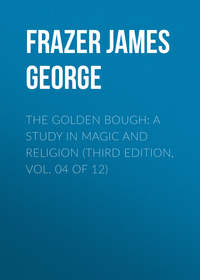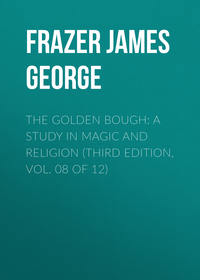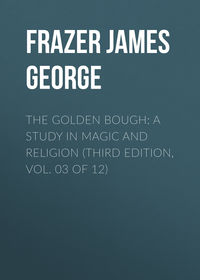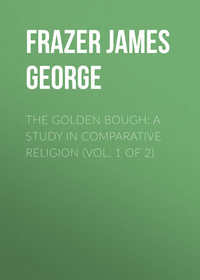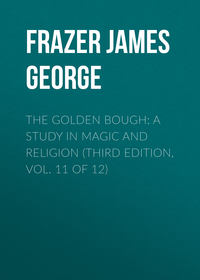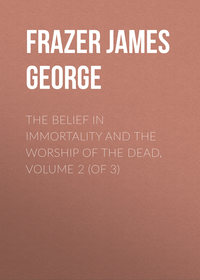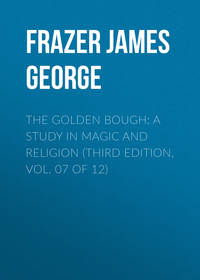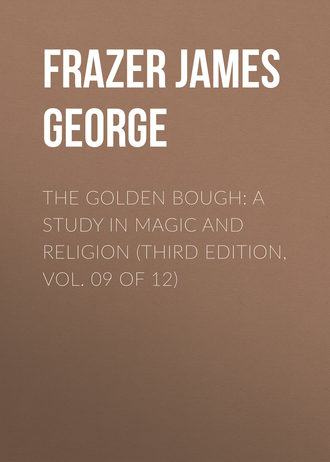 полная версия
полная версияThe Golden Bough: A Study in Magic and Religion (Third Edition, Vol. 09 of 12)
The ceremony was probably a purificatory rite designed to disarm and disable all evils that might threaten the Roman state in the course of the year. Roman cure for epilepsy.
In antiquity the annual practice of hammering a nail into a wall was not confined to Rome. It was observed also at Vulsinii, in Etruria, where the nails thus fixed in the temple of the goddess Nortia served as a convenient means of recording and numbering the years.230 To Roman antiquaries of a later period it seemed, naturally enough, that such a practice had indeed no other object than that of marking the flight of time in ages when writing was but little used.231 Yet a little reflection will probably convince us that this, though it was doubtless a useful consequence of the custom, can hardly have been its original intention. For it will scarcely be disputed that the annual observance of the custom cannot be wholly dissociated from its occasional observance in seasons of great danger or calamity, and that whatever explanation we give of the one ought to apply to the other also. Now it is plain that if we start from the annual observance and regard it as no more than a timekeeper or mode of recording the years, we shall never reach an adequate explanation of the occasional observance. If the nails were merely ready reckoners of the years, how could they come to be used as supreme remedies for pestilence, frenzy, and sedition, resorted to by the state in desperate emergencies when all the ordinary resources of policy and religion had failed? On the other hand, if we start from the occasional observance and view it, in accordance with modern analogies, as a rude attempt to dispose of intangible evils as if they were things that could be handled and put away out of sight, we can readily understand how such an attempt, from being made occasionally, might come to be repeated annually for the sake of wiping out all the old troubles and misfortunes of the past year and enabling the community to start afresh, unencumbered by a fardel of ills, at the beginning of a new year. Fortunately we can shew that the analogy which is thus assumed to exist between the Roman custom and modern superstition is not a merely fanciful one; in other words, it can be proved that the Romans, like modern clowns, did believe in the possibility of nailing down trouble, in a literal and physical sense, into a material substance. Pliny tells us that an alleged cure for epilepsy, or the falling sickness, was to drive an iron nail into the ground on the spot which was first struck by the patient's head as he fell.232 In the light of the modern instances which have come before us, we can hardly doubt that the cure was supposed to consist in actually nailing the disease into the earth in such a way that it could not get up and attack the sufferer again. Precisely parallel is a Suffolk cure for ague. You must go by night alone to a cross-road, and just as the clock strikes the midnight hour you must turn yourself about thrice and drive a tenpenny nail up to the head into the ground. Then walk away backwards from the spot before the clock is done striking twelve, and you will miss the ague; but the next person who passes over the nail will catch the malady in your stead.233 Here it is plainly assumed that the ague of which the patient is relieved has been left by him nailed down into the earth at the cross-road, and we may fairly suppose that a similar assumption underlay the Roman cure for epilepsy. Further, we seem to be now justified in holding that originally, when a Roman dictator sought to stay a plague, to restore concord, or to terminate an epidemic of madness by knocking a nail into a wall, he was doing for the commonwealth exactly what any private man might do for an epileptic patient by knocking a nail into the ground on the spot where his poor friend had collapsed. In other words, he was hammering the plague, the discord, or the madness into a hole from which it could not get out to afflict the community again.234
Knocking nails into idols as a means of attracting the attention of the deity or spirit.
Different in principle from the foregoing customs appears to be the Loango practice of sticking nails into wooden idols or fetishes. The intention of knocking a nail into a worshipful image is said to be simply to attract the notice of the deity in a forcible manner to the request of his worshipper; it is like pinching a man or running a pin into his leg as a hint that you desire to speak with him. Hence in order to be quite sure of riveting the god's attention the nails are sometimes made red-hot.235 Even the most absent-minded deity could hardly overlook a petition urged in so importunate a fashion. The practice is resorted to in many emergencies. For example, when a man has been robbed, he will go and get a priest to knock a nail into an idol. The sharp pang naturally exasperates the deity and he seeks to wreak his wrath on the thief, who is the real occasion of his suffering. So when the thief hears of what has been done, he brings back the stolen goods in fear and trembling. Similarly a nail may be knocked into an idol for the purpose of making somebody fall ill; and if a sick man fancies that his illness is due to an enemy who has played him this trick, he will send to the priest of the idol and pay him to remove the nail.236 This mode of refreshing the memory and stimulating the activity of a supernatural being is not confined to the negroes of Loango; it is practised also by French Catholics, as we learn from Sir John Rhys. “Some years ago,” he writes, “when I was on a visit at the late Ernest Renan's house at Rosmapamon, near Perros-Guirec on the north coast of Brittany, our genial host took his friends one day to see some of the sights of that neighbourhood. Among other things which he showed us was a statue of St. Guirec standing at the head of an open creek. It was of wood, and altogether a very rude work of art, if such it might be called; but what attracted our attention most was the fact that it had innumerable pins stuck into it. We asked M. Renan what the pins meant, and his explanation was exceedingly quaint. He said that when any young woman in the neighbourhood made up her mind that she should marry, she came there and asked the saint to provide her with a husband, and to do so without undue delay. She had every confidence in the willingness and ability of the saint to oblige her, but she was haunted by the fear that he might be otherwise engaged and forget her request. So she would stick pins into him, and thus goad him, as she fancied, to exert himself on her behalf. This is why the saint's statue was full of pins.”237 Similarly in Japan sufferers from toothache sometimes stick needles into a willow-tree, “believing that the pain caused to the tree-spirit will force it to exercise its power to cure.”238
Two different spiritual applications of nails or pins.
Thus it would seem that we must distinguish at least two uses of nails or pins in their application to spirits and spiritual influences. In one set of cases the nails act as corks or bungs to bottle up and imprison a troublesome spirit; in the other set of cases they act as spurs or goads to refresh his memory and stimulate his activity. But so far as the evidence which I have cited allows us to judge, the use of nails as spiritual bungs appears to be commoner than their use as mental refreshers.
Chapter II. The Omnipresence of Demons
Attempts to get rid of the accumulated sorrows of a whole people.
In the foregoing chapter the primitive principle of the transference of ills to another person, animal, or thing was explained and illustrated. A consideration of the means taken, in accordance with this principle, to rid individuals of their troubles and distresses led us to believe that at Rome similar means had been adopted to free the whole community, at a single blow of the hammer, from diverse evils that afflicted it. I now propose to shew that such attempts to dismiss at once the accumulated sorrows of a people are by no means rare or exceptional, but that on the contrary they have been made in many lands, and that from being occasional they tend to become periodic and annual.
Sorrows conceived of as the work of demons.
It needs some effort on our part to realise the frame of mind which prompts these attempts. Bred in a philosophy which strips nature of personality and reduces it to the unknown cause of an orderly series of impressions on our senses, we find it hard to put ourselves in the place of the savage, to whom the same impressions appear in the guise of spirits or the handiwork of spirits. For ages the army of spirits, once so near, has been receding further and further from us, banished by the magic wand of science from hearth and home, from ruined cell and ivied tower, from haunted glade and lonely mere, from the riven murky cloud that belches forth the lightning, and from those fairer clouds that pillow the silver moon or fret with flakes of burning red the golden eve. The spirits are gone even from their last stronghold in the sky, whose blue arch no longer passes, except with children, for the screen that hides from mortal eyes the glories of the celestial world. Only in poets' dreams or impassioned flights of oratory is it given to catch a glimpse of the last flutter of the standards of the retreating host, to hear the beat of their invisible wings, the sound of their mocking laughter, or the swell of angel music dying away in the distance. Far otherwise is it with the savage. To his imagination the world still teems with those motley beings whom a more sober philosophy has discarded. Fairies and goblins, ghosts and demons, still hover about him both waking and sleeping. They dog his footsteps, dazzle his senses, enter into him, harass and deceive and torment him in a thousand freakish and mischievous ways. The mishaps that befall him, the losses he sustains, the pains he has to endure, he commonly sets down, if not to the magic of his enemies, to the spite or anger or caprice of the spirits. Their constant presence wearies him, their sleepless malignity exasperates him; he longs with an unspeakable longing to be rid of them altogether, and from time to time, driven to bay, his patience utterly exhausted, he turns fiercely on his persecutors and makes a desperate effort to chase the whole pack of them from the land, to clear the air of their swarming multitudes, that he may breathe more freely and go on his way unmolested, at least for a time. Thus it comes about that the endeavour of primitive people to make a clean sweep of all their troubles generally takes the form of a grand hunting out and expulsion of devils or ghosts. They think that if they can only shake off these their accursed tormentors, they will make a fresh start in life, happy and innocent; the tales of Eden and the old poetic golden age will come true again.
Primitive belief in the omnipresence of demons.
Hence, before we review some examples of these spirit-hunts, it may be well to adduce evidence of the deep hold which a belief in the omnipresence and malignity of spirits has upon the primitive mind. The reader will be better able to understand the savage remedy when he has an inkling of the nature of the evil which it is designed to combat. In citing the evidence I shall for the most part reproduce the exact words of my authorities lest I should incur the suspicion of deepening unduly the shadows in a gloomy picture.
Demons in Australia and West Africa.
Thus in regard to the aborigines of Australia we are told that “the number of supernatural beings, feared if not loved, that they acknowledge is exceedingly great; for not only are the heavens peopled with such, but the whole face of the country swarms with them; every thicket, most watering-places, and all rocky places abound with evil spirits. In like manner, every natural phenomenon is believed to be the work of demons, none of which seem of a benign nature, one and all apparently striving to do all imaginable mischief to the poor blackfellow.”239 “The negro,” says another writer, “is wont to regard the whole world around him as peopled with invisible beings, to whom he imputes every misfortune that happens to him, and from whose harmful influence he seeks to protect himself by all kinds of magic means.”240 The Bantu negroes of Western Africa “regard their god as the creator of man, plants, animals, and the earth, and they hold that having made them, he takes no further interest in the affair. But not so the crowd of spirits with which the universe is peopled, they take only too much interest, and the Bantu wishes they would not and is perpetually saying so in his prayers, a large percentage whereof amounts to, ‘Go away, we don't want you.’ ‘Come not into this house, this village, or its plantations.’ ” Almost all these subordinate spirits are malevolent.241 A similar but fuller account of the West African creed is given by a German writer, whose statements apply particularly to the Ewe-speaking negroes of the Slave Coast. He says: “Thus the term fetishism denotes the attitude of the Ewes, or of West African negro tribes in general, towards magic; it forms one of the principal constituents of their religion. The other main constituent is their attitude to the gods, which is properly demonolatry. The Ewe names the gods drowo, that is, intermediaries, namely, between a Supreme Being, whom he calls Mawu (‘the Unsurpassable’), and mankind. The drowo with whom the Ewe has to do, to whom his offerings and his respects are paid, are thus subordinate deities, who according to the etymological meaning of the word dro are conceived as judging, composing disputes, and mediating among men. The existence of a Supreme Being is by no means unfamiliar to the Ewe; he has his Mawu often in his mouth, especially in talking with the missionary, and he willingly acknowledges that Mawu created him and the gods. But he can only conceive of this Supreme Being on the analogy of his own personality and not as omnipresent and so forth. It is impossible that this Mawu can trouble himself about details in the creation or even about every individual man and his petty affairs; what would be the use of the many higher and lower spirits with which the world is filled before his eyes? The West African perhaps conceives of God as transcendant, but not as immanent; a creation he possibly apprehends, but not an omnipresent government of the world by the Supreme Being. That government is carried on by Mawu at a distance by means of the many spirits or subordinate gods whom he has created for the purpose… A portion of the gods fills the air, wherefore the forces and the phenomena of nature are deified as their manifestations. The elements are thought to be moved by the gods of the air. In the storm and the wind, in thunder and lightning the Ewe sees the manifestation of particularly powerful gods. In the mysterious roll and roar of the deep sea the Ewe, like the negro in general, beholds the sway of a very mighty god or of a whole host of gods. Further, the earth itself is also the abode of a multitude of spirits or gods, who have in it their sphere of activity. They inhabit certain great mountains, great hollow trees, caves, rivers, and especially woods. In such woods of the gods no timber may be felled. Thus the gods fill not only the air and the sea, they also walk on earth, on all paths; they lurk under the trees, they terrify the lonely wayfarer, they disquiet and plague even the sleeper. When the negro rises from the stool on which he has been sitting, he never fails to turn it upside down, to prevent a spirit from sitting down on it… The spirit-world falls into two main classes: there are good and kindly spirits, whose help is eagerly sought by offerings; but there are also gloomy and revengeful spirits, whose approach and influence people eagerly endeavour to avert, and against whom all possible means are employed to ban them from the houses and villages. The people are much more zealous in their devotion to the evil spirits than in their devotion to the good. The reason is that the feeling of fear and the consciousness of guilt are much stronger than the emotions of love and gratitude for benefits received. Hence the worship of the false gods or spirits among this people, and among the West African negro tribes in general, is properly speaking a worship of demons or devils.”242
Demons on the Congo. Demons in South Africa.
Again, a missionary who spent fifteen years among the Boloki of the Upper Congo River tells us that “the religion of the Boloki has its basis in their fear of those numerous invisible spirits which surround them on every side, and are constantly trying to compass their sickness, misfortune and death; and the Boloki's sole object in practising their religion is to cajole, or appease, cheat, or conquer and kill those spirits that trouble them – hence their nganga [medicine-men], their rites, their ceremonies and their charms. If there were no evil spirits to be circumvented there would be no need of their medicine men and their charms.”243 “The Boloki folk believe they are surrounded by spirits which try to thwart them at every twist and turn, and to harm them every hour of the day and night. The rivers and creeks are crowded with the spirits of their ancestors, and the forests and bush are full also of spirits, ever seeking to injure the living who are overtaken by night when travelling by road or canoe. I never met among them a man daring enough to go at night through the forest that divided Monsembe from the upper villages, even though a large reward was offered. Their invariable reply was: ‘There are too many spirits in the bush and forest.’ ”244 The spirits which these people dread so much are the mingoli or disembodied souls of the dead; the life of the Boloki is described as “one long drawn out fear of what the mingoli may next do to them.” These dangerous beings dwell everywhere, land and water are full of them; they are ever ready to pounce on the living and carry them away or to smite them with disease and kill them. Though they are invisible to common eyes, the medicine-man can see them, and can cork them up in calabashes or cover them up with saucepans; indeed, if it is made worth his while, he can even destroy them altogether.245 Again, of the Bantu tribes of South Africa we read that “nearer than the spirits of deceased chiefs or of their own ancestors was a whole host of hobgoblins, water sprites, and malevolent demons, who met the Bantu turn which way they would. There was no beautiful fairyland for them, for all the beings who haunted the mountains, the plains, and the rivers were ministers of evil. The most feared of these was a large bird that made love to women and incited those who returned its affection to cause the death of those who did not, and a little mischievous imp who was also amorously inclined. Many instances could be gathered from the records of magistrates' courts in recent years of demented women having admitted their acquaintance with these fabulous creatures, as well as of whole communities living in terror of them.”246 However, it would be no doubt a great mistake to imagine that the minds of the Bantu, or indeed of any savages, are perpetually occupied by a dread of evil spirits;247 the savage and indeed the civilized man is incapable, at least in his normal state, of such excessive preoccupation with a single idea, which, if prolonged, could hardly fail to end in insanity.
Demons in South America.
Speaking of the spirits which the Indians of Guiana attribute to all objects in nature, Sir Everard F. im Thurn observes that “the whole world of the Indian swarms with these beings. If by a mighty mental effort we could for a moment revert to a similar mental position, we should find ourselves everywhere surrounded by a host of possibly hurtful beings, so many in number that to describe them as innumerable would fall ridiculously short of the truth. It is not therefore wonderful that the Indian fears to move beyond the light of his camp-fire after dark, or, if he is obliged to do so, carries a fire-brand with him that he may at least see among what enemies he walks; nor is it wonderful that occasionally the air round the settlement seems to the Indian to grow so full of beings, that a peaiman [sorcerer], who is supposed to have the power of temporarily driving them away, is employed to effect a general clearance of these beings, if only for a time. That is the main belief, of the kind that is generally called religious, of the Indians of Guiana.”248 The Lengua Indians of the Paraguayan Chaco believe in certain demons which they call kilyikhama. “The kilyikhama are confined to no particular place. Time and distance do not seem to affect them in the least. They are held in great awe by the Indian, and whithersoever he turns, whether by day or night, but particularly at night, he is subject to their malign influences… They live in constant dread of these supernatural beings, and if nothing else contributed to make their life miserable, this ever-present dread of the kilyikhama would be in itself quite sufficient to rob it of most of its joy.”249
Demons in Labrador.
Very different from the life of these Indians of the South American forests and prairies is the life of the Esquimaux on the desolate shores of Labrador; yet they too live in like bondage to the evil creatures of their own imagination. “All the affairs of life are supposed to be under the control of spirits, each of which rules over a certain element, and all of which are under the direction of a greater spirit. Each person is supposed to be attended by a special guardian who is malignant in character, ever ready to seize upon the least occasion to work harm upon the individual whom it accompanies. As this is an evil spirit, its good offices and assistance can be obtained by propitiation only. The person strives to keep the good-will of the evil spirit by offerings of food, water, and clothing.” “Besides this class of spirits, there are the spirits of the sea, the land, the sky (for be it understood that the Eskimo know nothing of the air), the winds, the clouds, and everything in nature. Every cove of the sea-shore, every point, island, and prominent rock has its guardian spirit. All are of the malignant type, and to be propitiated only by acceptable offerings from persons who desire to visit the locality where it is supposed to reside. Of course some of the spirits are more powerful than others, and these are more to be dreaded than those able to inflict less harm. These minor spirits are under the control of the great spirit, whose name is Tung ak. This one great spirit is more powerful than all the rest besides. The lesser spirits are immediately under his control and ever ready to obey his command. The shaman (or conjuror) alone is supposed to be able to deal with the Tung ak. While the shaman does not profess to be superior to the Tung ak, he is able to enlist his assistance and thus be able to control all the undertakings his profession may call for. This Tung ak is nothing more or less than death, which ever seeks to torment and harass the lives of people that their spirits may go to dwell with him.”250
Demons in Polynesia. Demons in New Zealand.
Brighter at first sight and more pleasing is the mythology of the islanders of the Pacific, as the picture of it is drawn for us by one who seems to have felt the charm of those beliefs which it was his mission to destroy. “By their rude mythology,” he says, “each lovely island was made a sort of fairy-land, and the spells of enchantment were thrown over its varied scenes. The sentiment of the poet that
‘Millions of spiritual creatures walk the earth,Unseen, both when we wake, and when we sleep,’was one familiar to their minds; and it is impossible not to feel interested in a people who were accustomed to consider themselves surrounded by invisible intelligences, and who recognized in the rising sun – the mild and silver moon – the shooting star – the meteor's transient flame – the ocean's roar – the tempest's blast, or the evening breeze – the movements of mighty spirits. The mountain's summit, and the fleecy mists that hang upon its brows – the rocky defile – the foaming cataract – and the lonely dell – were all regarded as the abode or resort of these invisible beings.”251 Yet the spiritual powers which compassed the life of the islanders on every side appear to have been far from friendly to man. Speaking of their beliefs touching the souls of the dead, the same writer says that the Polynesians “imagined they lived in a world of spirits, which surrounded them night and day, watching every action of their lives, and ready to avenge the slightest neglect or the least disobedience to their injunctions, as proclaimed by their priests. These dreaded beings were seldom thought to resort to the habitations of men on errands of benevolence.”252 The Tahitians, when they were visited by Captain Cook, believed that “sudden deaths and all other accidents are effected by the immediate action of some divinity. If a man only stumble against a stone and hurt his toe, they impute it to an Eatooa; so that they may be literally said, agreeably to their system, to tread enchanted ground.”253 “The Maori gods,” says a well-informed writer, “were demons, whose evil designs could only be counteracted by powerful spells and charms; these proving effectual, sacrifices and offerings were made to soothe the vanquished spirits and appease their wrath.” “The gods in general appeared in the whirlwind and lightning, answering their votaries in the clap of thunder. The inferior beings made themselves visible in the form of lizards, moths, butterflies, spiders, and even flies; when they spoke it was in a low whistling tone. They were supposed to be so numerous as to surround the living in crowds, kei te muia nga wairua penei nga wairoa, ‘the spirits throng like mosquitoes,’ ever watching to inflict evil.”254


